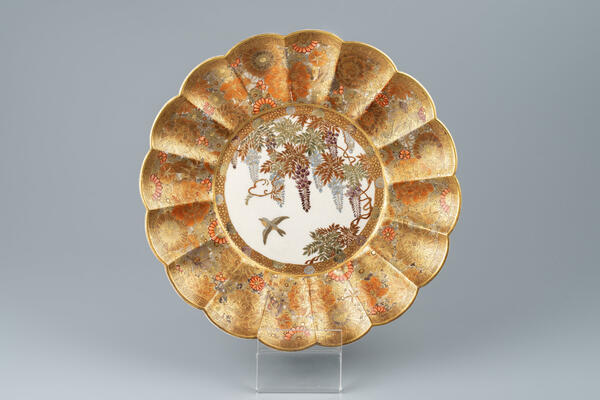The Samara Regional Art Museum houses a bright example of Japanese 19th–century porcelain — a plate with an image of wisteria branch.
Porcelain production in Japan began quite late, if compared with neighboring China and Korea, in the 17th century. Several hundred Korean potters who were brought to the island of Kyushu by a local ruler played the most important role at the early stage of porcelain production. The history of the famous Satsuma porcelain began on this island. In Kyoto, the capital of Japan since the 8th century, a political and cultural center and a place where artists concentrated, porcelain was not produced until the 18th century.
The beginning of porcelain production in Kyoto is often associated with the name of the outstanding master Kinkozan Sobei VI. In the 1870s, Kinkozan VI (1823 — 1884) founded a large ceramic center in Kyoto to produce items for export. Products in the Satsuma style from this center were highly appreciated at international exhibitions in Philadelphia and Paris in 1878.
The first official major exhibition of Japanese art in the West took place at the International Exposition of 1867 in Paris. Kinkozan’s ceramic ware was among the exhibits and literally conquered the European public. Kinkozan Sobei VI was succeeded by his student Kinkozan VII.
A small workshop, hidden from prying eyes, was located next to industrial plants. There, the ceramic artist worked alone, creating unique items for collectors and connoisseurs. The exhibits from the collection of the Samara Museum were created by the artist Kinkozan VII.
The picturesque décor of products from Kinkozan workshops in Kyoto was distinguished by unique taste and skill. The outstanding level of artistry of Kinkozan porcelain is fully represented in the plate with a chrysanthemum pattern with stylized scalloped edges. A flowering wisteria and a nightingale are depicted in the circular alcove.
Wisteria in Japan symbolizes fragility, refinement, tenderness and purity. And the nightingale is associated with love and spring. The wide edge of the plate in the shape of a sixteen-petalled chrysanthemum flower is gilded with the image of peony and chrysanthemum flowers. The décor of the plate is replete with symbols of tenderness and love. The artist painted subtly and elegantly.
Porcelain production in Japan began quite late, if compared with neighboring China and Korea, in the 17th century. Several hundred Korean potters who were brought to the island of Kyushu by a local ruler played the most important role at the early stage of porcelain production. The history of the famous Satsuma porcelain began on this island. In Kyoto, the capital of Japan since the 8th century, a political and cultural center and a place where artists concentrated, porcelain was not produced until the 18th century.
The beginning of porcelain production in Kyoto is often associated with the name of the outstanding master Kinkozan Sobei VI. In the 1870s, Kinkozan VI (1823 — 1884) founded a large ceramic center in Kyoto to produce items for export. Products in the Satsuma style from this center were highly appreciated at international exhibitions in Philadelphia and Paris in 1878.
The first official major exhibition of Japanese art in the West took place at the International Exposition of 1867 in Paris. Kinkozan’s ceramic ware was among the exhibits and literally conquered the European public. Kinkozan Sobei VI was succeeded by his student Kinkozan VII.
A small workshop, hidden from prying eyes, was located next to industrial plants. There, the ceramic artist worked alone, creating unique items for collectors and connoisseurs. The exhibits from the collection of the Samara Museum were created by the artist Kinkozan VII.
The picturesque décor of products from Kinkozan workshops in Kyoto was distinguished by unique taste and skill. The outstanding level of artistry of Kinkozan porcelain is fully represented in the plate with a chrysanthemum pattern with stylized scalloped edges. A flowering wisteria and a nightingale are depicted in the circular alcove.
Wisteria in Japan symbolizes fragility, refinement, tenderness and purity. And the nightingale is associated with love and spring. The wide edge of the plate in the shape of a sixteen-petalled chrysanthemum flower is gilded with the image of peony and chrysanthemum flowers. The décor of the plate is replete with symbols of tenderness and love. The artist painted subtly and elegantly.




